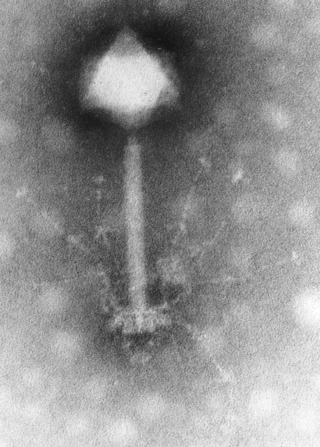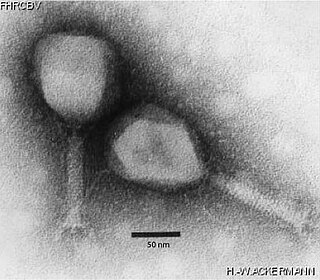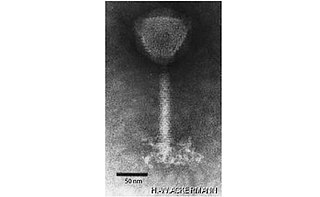Virus classification is the process of naming viruses and placing them into a taxonomic system similar to the classification systems used for cellular organisms.

Myoviridae is a family of bacteriophages in the order Caudovirales. Bacteria and archaea serve as natural hosts. There are 625 species in this family, assigned to eight subfamilies and 217 genera.

Podoviridae is a family of bacteriophage in the order Caudovirales often associated with T-7 like phages. There are 130 species in this family, assigned to 3 subfamilies and 52 genera. This family is characterized by having very short, noncontractile tails. Podoviradae are largely understudied and most new isolates are of the phicbkviruses genus, a group of giant viruses that appear to be Caulobacter specific.
Luteoviridae was a family of viruses. The family was abolished in 2020 based on evidence that its three genera and seven species unassigned to a genus belonged to two other, existing families.

Tombusviridae is a family of single-stranded positive sense RNA plant viruses. There are three subfamilies, 17 genera, and 95 species in this family. The name is derived from Tomato bushy stunt virus (TBSV).

Alphaherpesvirinae is a subfamily of viruses in the family Herpesviridae, primarily distinguished by reproducing more quickly than other subfamilies in the Herpesviridae. In animal virology the most important herpesviruses belong to the Alphaherpesvirinae. Pseudorabies virus is the causative agent of Aujeszky's disease in pigs and Bovine herpesvirus 1 is the causative agent of bovine infectious rhinotracheitis and pustular vulvovaginitis. Mammals serve as natural hosts. There are currently 45 species in this subfamily, divided among 5 genera with one species unassigned to a genus. Diseases associated with this subfamily include: HHV-1 and HHV-2: skin vesicles or mucosal ulcers, rarely encephalitis and meningitis, HHV-3: chickenpox (varicella) and shingles, GaHV-2: Marek's disease.

The International Committee on Taxonomy of Viruses (ICTV) authorizes and organizes the taxonomic classification of and the nomenclatures for viruses. The ICTV has developed a universal taxonomic scheme for viruses, and thus has the means to appropriately describe, name, and classify every virus that affects living organisms. The members of the International Committee on Taxonomy of Viruses are considered expert virologists. The ICTV was formed from and is governed by the Virology Division of the International Union of Microbiological Societies. Detailed work, such as delimiting the boundaries of species within a family, typically is performed by study groups of experts in the families.

Avulavirinae is a subfamily of viruses in the family Paramyxoviridae. Members of the subfamily are collectively known as avulaviruses. All members of the subfamily primarily infect birds. Avulavirinae was previously recognized as the genus Avulavirus before being elevated to a subfamily. The term avula comes from "avian rubula", distinguishing it from rubulaviruses of the subfamily Rubulavirinae due to avulaviruses only infecting birds and translating protein V from an edited RNA transcript. The most notable avulavirus is the Newcastle disease virus, a strain of Avian orthoavulavirus 1.
Carmovirus was a genus of viruses. The genus was split in 2015 into three genera, each retaining -carmovirus as part of their name:

The Herpesvirales is an order of dsDNA viruses with animal hosts, characterised by a common morphology consisting of an icosahedral capsid enclosed in a glycoprotein-containing lipid envelope. Common infections in humans caused by members of this order include cold sores, genital herpes, chickenpox, shingles, and glandular fever. Herpesvirales is the sole order in the class Herviviricetes, which is the sole class in the phylum Peploviricota.

Globuloviridae is a family of hyperthermophilic archaeal viruses. Crenarchaea of the genera Pyrobaculum and Thermoproteus serve as natural hosts. There are four species in this family, assigned to a single genus, Alphaglobulovirus.

Secoviridae is a family of viruses in the order Picornavirales. Plants serve as natural hosts. There are 8 genera and 86 species in this family, one of which is unassigned to a genus. The family was created in 2009 with the grouping of families Sequiviridae, now dissolved, and Comoviridae, now subfamily Comovirinae, along with the then unassigned genera Cheravirus, Sadwavirus, and Torradovirus.
Proboscivirus is a genus of viruses in the order Herpesvirales, in the family Herpesviridae, in the subfamily Betaherpesvirinae. Elephants serve as natural hosts. EEHV1 is apathogenic for African elephants but causes fatal haemorrhagic disease in Asian elephants. The name "Proboscivirus" comes from the Greek word προβοσκίς or "proboscis" meaning "the elephant trunk," for which the virus accordingly uses as its means of contraction and transmission to enter the elephant's body.

Tevenvirinae is a subfamily of viruses in the order Caudovirales, in the family Myoviridae. Bacteria and archaea serve as natural hosts. There are 135 species in this subfamily, most included in 12 genera.
Bdellomicrovirus is a genus of viruses, in the family Microviridae, in the subfamily Gokushovirinae. Bdellovibrio bacteria serve as natural hosts. There are two species in this genus.
Chlamydiamicrovirus is a genus of viruses, in the family Microviridae, in the subfamily Gokushovirinae. Various species of chlamidia serve as natural hosts. There are four species in this genus.
Bullavirinae is a subfamily of viruses in the family Microviridae. Enterobacteria serve as natural hosts. There are 14 species in this subfamily, organized into three genera.
Eucampyvirinae is a subfamily of viruses in the order Caudovirales, in the family Myoviridae. Bacteria of the genus Campylobacter serve as natural hosts. There are 9 species in this subfamily, assigned to 2 genera.
Ackermannviridae is a family of viruses in the order Caudovirales. Gammaproteobacteria in the phylum Pseudomonadota serve as natural hosts. There are 2 subfamilies, 10 genera, and 63 species in the family.

Herelleviridae is a family of bacterial viruses of the order Caudovirales infecting members of the phylum Firmicutes. The family has five subfamilies, 33 genera and 92 species.










